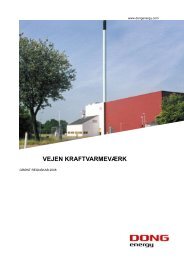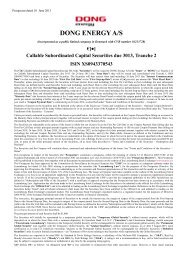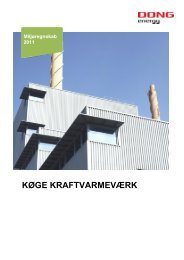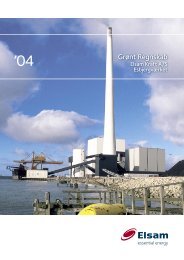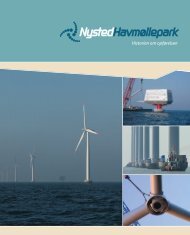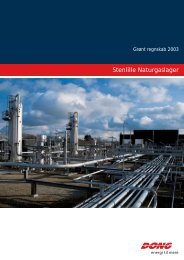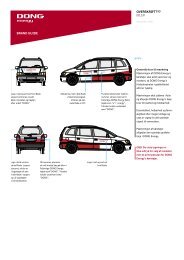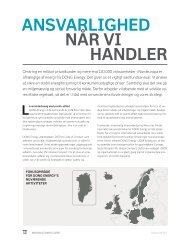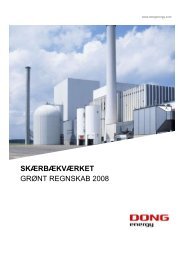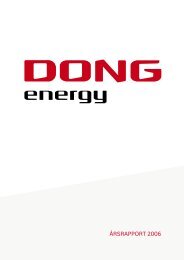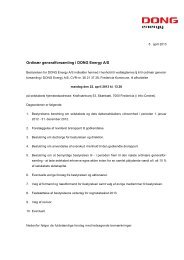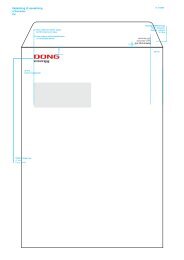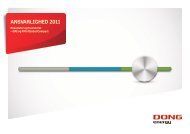ANNUAL REPORT 2011 - DONG Energy
ANNUAL REPORT 2011 - DONG Energy
ANNUAL REPORT 2011 - DONG Energy
Create successful ePaper yourself
Turn your PDF publications into a flip-book with our unique Google optimized e-Paper software.
New presentation of profit for the year<br />
focusing on business performance<br />
<strong>DONG</strong> <strong>Energy</strong> has expanded its business activities in several<br />
energy markets in recent years. As a result, the Group<br />
has adopted a more active risk management approach in<br />
some areas in order to enhance value creation and create a<br />
greater degree of certainty with respect to the Group’s financial<br />
position.<br />
This is achieved by hedging all or part of the value of<br />
the Group’s production and purchases and sales of energy<br />
to avoid performance being affected by unfavourable<br />
movements in market prices.<br />
As a hedging instrument that precisely matches the underlying<br />
commercial exposure (production or trading) or is<br />
sufficiently liquid is not always available, the Group uses<br />
approximation hedging, to some extent, i.e. hedging in alternative<br />
markets or with different time frames. For example,<br />
Danish electricity generation is, to some extent,<br />
hedged using financial contracts for the EEx and Nord Pool<br />
areas, as these prices normally move uniformly over time.<br />
Accordingly, only a portion of the Group’s economic<br />
hedging meets the IFRS criteria for cash flow hedge accounting,<br />
even though they have been entered into precisely<br />
for this purpose. If the criteria are not satisfied, the<br />
hedging transactions must be market value adjusted on a<br />
continuous basis, which may give rise to large fluctuations<br />
in the income statement, regardless of the fact that the<br />
hedging transactions have reduced the financial risk.<br />
With effect from 1 January <strong>2011</strong>, the Group therefore<br />
changed the way in which it accounts for derivative financial<br />
instruments used to hedge future cash flows relating<br />
to commodities and related currency exposures, so that<br />
these are no longer classified as hedge accounting.<br />
Instead, an alternative performance measure, business<br />
performance, has been introduced to ensure greater transparency<br />
in the financial reporting. In the income statement,<br />
the business performance results are shown in connection<br />
with the results determined in accordance with<br />
IFRS. The difference between the two performance<br />
measures is shown as adjustments.<br />
Connection between these performance measures<br />
The business performance results reflect the internal<br />
management of the Group. The results have been adjusted<br />
for temporary fluctuations in the market value of contracts,<br />
including hedging transactions relating to other periods.<br />
The financial effect of this hedging is therefore recognised<br />
in the income statement in the same period as the hedged<br />
commercial exposure. This way, the business performance<br />
income statement better represents the underlying financial<br />
performance of the Group during the period.<br />
In future, hedging transactions relating to the commercial<br />
exposures referred to above will be recognised at fair<br />
value with value adjustment via the income statement in<br />
the IFRS financial statements, regardless of the period to<br />
which they relate. As <strong>DONG</strong> <strong>Energy</strong> enters into hedging<br />
transactions with terms of up to five years, this may have a<br />
major impact on the results for individual reporting periods.<br />
The timing differences relating to movements in the market<br />
value of contracts, including hedging transactions that are<br />
deferred to the period in which they are to be recognised, are<br />
shown as an adjustment between the performance measures.<br />
These adjustments will accumulate to nil over time.<br />
The accounting treatment of trading activities remains<br />
unchanged compared with previous periods so that market<br />
value adjustments of these transactions are recognised in<br />
the period in which the change in value occurs and with the<br />
same effect on the IFRS and business performance results.<br />
Unless otherwise stated, Management’s review comments<br />
on the business performance results.<br />
physical electricity and gas contracts<br />
As part of its overall risk management, the Group enters<br />
into fixed-price contracts on purchase and sale of physical<br />
electricity and gas on exchanges and hubs with a view to<br />
mitigate risk related to future settlement prices. The Group<br />
also enters into fixed-price contracts with customers in the<br />
course of its commercial activities.<br />
Under IFRS, these contracts must, as a rule, be classified<br />
as financial contracts with continuous market value adjustment<br />
in the income statement, if a liquid market exists<br />
in which the underlying commercial exposure (production,<br />
purchase or sale) can be traded. If this is not the case, the<br />
financial effect of the contracts will not be recognised until<br />
the reporting period in which the commercial exposure is<br />
realised (accrual accounting).<br />
Physical fixed-price electricity and gas contracts will, in<br />
future, be recognised in the business performance results in<br />
the period in which the hedged exposure is realised, regardless<br />
of whether the market is liquid or illiquid.<br />
As the Group’s risk management comprises both financial<br />
and physical fixed-price contracts, these are reported<br />
on collectively as hedging transactions.<br />
Difference in EBitDa for <strong>2011</strong> between<br />
business performance and ifrs<br />
The difference between the business performance and<br />
IFRS results affects both revenue and cost of sales. In <strong>2011</strong>,<br />
the difference in EBITDA was DKK 1.8 billion.<br />
EBitDa, DKK million <strong>2011</strong><br />
Business performance 13,770<br />
Initial recognition of certain physical fi xedprice<br />
electricity and gas contracts for delivery<br />
in other periods (1,817)<br />
Market value adjustments for the period of<br />
fi nancial and physical hedging contracts<br />
relating to other periods 3,267<br />
Deferred losses/gains relating to fi nancial and<br />
physical hedging contracts where the hedged<br />
production or trading is recognised in the period<br />
under review 375<br />
total adjustments 1,825<br />
Of which recognised in revenue 1,595<br />
ifrs 15,595<br />
<strong>DONG</strong> ENERGY <strong>DONG</strong> ENERGY GROUP <strong>ANNUAL</strong> <strong>REPORT</strong> <strong>2011</strong> – manaGEmEnt’s rEviEw 33



